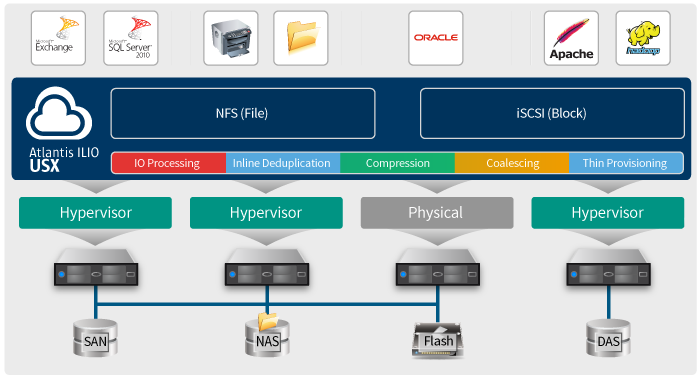This post is also available in: Italian
Reading Time: 5 minutes During the first day of the third edition of Virtualization Field Day (#VFD3) one of the companies that we (as delegates) met was Atlantis Computing that was a well known company VDI environments, but some weeks ago they have also enter officially in the storage arena with the announce of Atlantis ILIO USX™ (Unified Software-defined Storage) solution.
During the first day of the third edition of Virtualization Field Day (#VFD3) one of the companies that we (as delegates) met was Atlantis Computing that was a well known company VDI environments, but some weeks ago they have also enter officially in the storage arena with the announce of Atlantis ILIO USX™ (Unified Software-defined Storage) solution.
I’ve already write about Atlantis ILIO products and how their unique host caching solution could be interesting in several cases (mostly in VDI environments). Those solutions are appreciated by more than 440 customers (500,000 VM licenses sold globally).
But the Atlantis ILIO USX™ solution change all the rules, bringing a Software-defined Storage (100% software based) purpose-built for virtualized server workloads such as databases, big data and any line of business application.
Is it just a product evolution, or it’s (or it could) become some kind of revolution in the storage based on virtual storage appliances (VSAs)?
 Of course during the #VDF3 sessions we have talk about this product: Atlantis ILIO USX is a unique in-memory software-defined storage solution that can pool and optimize any class of storage including SAN, NAS, RAM or any type of DAS (SSD, Flash, SAS) to create hybrid, hyper-converged or all-flash storage from existing datacenter resources.
Of course during the #VDF3 sessions we have talk about this product: Atlantis ILIO USX is a unique in-memory software-defined storage solution that can pool and optimize any class of storage including SAN, NAS, RAM or any type of DAS (SSD, Flash, SAS) to create hybrid, hyper-converged or all-flash storage from existing datacenter resources.
What that make this solution unique is their approach: use (part) of the host RAM as a pooled resource of a distributed storage. Sounds similar to have a host cache solution, but it isn’t: usually host cache solutions works on flash (and RAM is much faster) and also their are working with caching techniques and no more (usually). Of course this mean that you will loose part of your local host resources (mainly 1-2 cores and the defined RAM allocated at the virtual appliance), but you can design your host to take care of this aspects.
Atlantis ILIO USX technical features are more complete:
- Content-Aware IO Optimization: uses its intelligence to differentiate between transient and stateful operations that require durable storage
- In-line Deduplication: considering that all work is done in RAM it’s possible use this technology to optimized the used RAM
- Wire-speed Compression: similar to the one used from VMware to optimize the memory, and again used to optimzed the used RAM
- Real-Time Write Coalescing: a way to optimize the I/O considering that each VM OS is already trying to optimize them (by thinking that it has the exclusive access)
- HA/DR with Atlantis ILIO: using ILIO Snap Clone for stateless desktops or ILIO Fast Replication for persistent desktops
Those set of features become usable on each kind of storage (NFS, SAN, DAS, …):
Does this product replace existing storage solutions? Not necessary, because it could work with existing product to add more features.
A big example is ILIO USX with VSAN (recently announced in GA), two highly complementary software-defined solutions: Atlantis ILIO USX supports VMware VSAN and delivers additional performance and enterprise-class data services while allowing existing shared storage assets to be deployed in conjunction with VMware VSAN. While both Atlantis USX and VMware VSAN are implementations of software-defined storage, the combination should spur many existing customers with shared storage to adopt VSAN even more rapidly.
Same it’s for other storage vendors, and there are several user cases (especially for the VDI environments) with Atlantis ILIO combined with other storage, included full flash based storage.
Another big plus is that this solution is completely hypervisor agnostic: actually works with VMware vSphere, but soon will be available for Microsoft Hyper-V and other hypervisors.
Another interesting aspect is the ability of build the storage that you want, considering that using this solution permit to implement those kind of scenarios:
- Software-defined “In-Memory” storage: using only RAM to build really fast VMs (costly but interesting for some kind of VDI scenarios)
- Software-defined all-flash storage: using any combination of shared and local flash to amplify the flash storage capacity by up to 5x
- Software-defined hybrid storage: using server RAM and existing shared SAN or NAS storage to boost performance and increase the number of VMs supported
- Software-defined hyper-converged storage: using each servers’ RAM, Flash and SAS to create an integrated storage and compute platform
For more information see also:
- Atlantis Computing @#VFD3 (Tech Field Day 3 – Virtualization)
- #VFD3 Day One – Atlantis Computing’s 1 Million IOPS
- Software Defined Storage Is Officially “A Thing” And Worth Considering For Your Data Center
- Tech Field Day VFD3 – Atlantis Computing ILIO USX – Bring the USX-y back
- Atlantis ILIO USX, In-Memory Performance for Servers
- Atlantis Computing … A different approach at VFD3
Disclaimer: I’ve been invited to this event by Gestalt IT and they will paid for accommodation and travels, but I’m not compensated for my time and I’m not obliged to blog. Furthermore, the content is not reviewed, approved or published by any other person than me.




